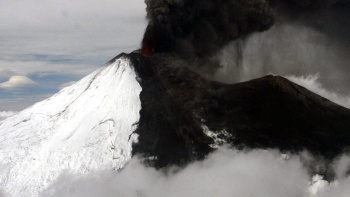
Llaima erupting in April 2009.
Just a quick note about the eruption currently ongoing at Llaima in Chile. The volcano continues to explosively (and effusively) erupt, sending ash ~22,000 feet / 7,000 meters into the air. This eruption has produced 37 hours of intense eruption (in spanish) so far and the ash from the eruption is drifting into Argentina, almost 100 km to the SE of the volcano. More evacuations are being called for by ONEMI and so far 71 people have left the vicinity of the volcano due to fears of lahars and significant ash fall (In spanish, but it does provide video of the eruption). There is also some great video of the eruption (in spanish again) here.
- Log in to post comments
I'm curious as to what kind of gas dynamics at this volcano would permit a 7 km ash plume (according to the Reuters article) to exist while a lava flow is calmly being extruded? A lava fountain achieves both explosivity and effusivity, but this seems far more explosive than Hawaiian activity allows. Perhaps there are two separate vents, one with a more viscous, gas-rich magma (the volcano erupts basaltic-andesite to basalt which, under the right conditions, could cool and form some nice plagioclase crystals increasing viscosity and allowing gas to get in there and build up, making it a frothy, partially solidified magma, which, when released, would create a plume like that), and a second one erupting magma that has travelled more directly from the magma chamber without the chance to cool or build up gas pressure. Another explanation (that seems most probable to me at least) may involve water, where some of the lava erupted is not encountering water on its way to the surface, keeping its gas content low, while water inundates another area of the summit, causing explosive activity whenever it meets the magma rising from the magma chamber. After all, the volcano is covered by a very large glacier that provides a readily available water source. And if this is indeed the explanation, what is preventing water from infiltrating the fissures from which the lava flows extrude?
Looking to the Global Volcanism Program's website, apparently explosive eruptions accompanied by lava flows frequently occur on this mountain. I wonder if all or most of these have simply involved water being in one place and not another? If climate change removes the summit glacier, will the volcano be less hazardous ( ;) ). What's your opinion, Dr. Klemetti?
That is some serious ashfall.
I wonder what the chemistry of llaima is like.
It is not too uncommon to have volcanic eruptions that have both an effusive and explosive component. We see that a lot in places like Hawai'i, where there can be fire fountaining and lava flows from the same vents. My guess here is that the lava erupting at Llaima is just especially volatile rich when it erupts, producing the fire fountaining (and the ash) along with lava flows - and the eruptive style typical for Llaima - strombolian & hawaiian - bears that out. Even with a lot of volatiles, low viscosity magmas may both explode and flow out of the vent - however, if anyone who works on these types of eruptions has something more specific to say, please chime in (I'm still stuck on my dacites and rhyolites). Most of the lavas erupted at Llaima are basaltic to andesite, which also makes sense for the style of eruption we're seeing now. You can even see the fire fountain in the picture at the top if you look closely for the red at the summit.
Erik, you're right, it's a question of volatile content in the magma. More than anything else - perhaps together with external water such as a lake, ocean or ground water - it's the gas content (especially water vapor and carbon dioxide) that make an eruption explosive. Forget all the stuff about silica content. Mount St. Helens erupted highly silicic dacite in 2004-2008 virtually non-explosively. Etna and Llaima, in contrast, along with a number of other basaltic volcanoes, are capable of producing surprisingly intense explosive activity. Lava is produced in many of these, often from vents closely associated with the explosive ones, though distinct and separate. It's always the morphologically higher vent that produces the explosive activity, whereas effusive activity occurs downslope.
The thing I would be concerned about at Llaima is that the volcano might produce a flank eruption (the first for more than 50 years), given the high levels of activity it shows since January 2008. Although the volcano is less densely populated than Etna, a major flank eruption might be disruptive and destructive. We've seen, once more, similar things at Etna, where flank eruptions were preceded by these peculiar sequences of paroxysms with lava fountains, flows, and tephra production. So I would not be surprised to hear much more about Llaima in the near future.
Looking to the Global Volcanism Program's website, apparently explosive eruptions accompanied by lava flows frequently occur on this mountain. I wonder if all or most of these have simply involved water being in one place and not another?